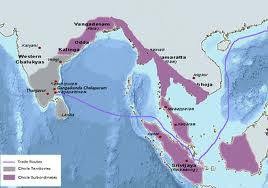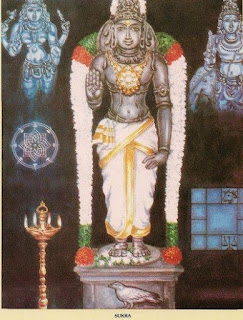THE PERIOD OF HINDU KINGDOMS
Many well-organized kingdoms with a high degree of civilization were ruled by indigenous kings who had adopted the Hindu or Buddhist religion. This explains why this period in history is called the Period of Hindu Kingdoms. It lasted from ancient times to the 16th Century AD. Because the culture and civilization, which emanated from the Hindu and Buddhist religions, were syncretized with the local cultural elements, the period was also referred to as the Hindu-Indonesian period.
Indian culture and customs were introduced, such as the system of government in a monarchy, the ancestry system, the organization of military troops, literature, music and dances, architecture, religious practices and rituals, and even the division of laborers into castes or varnas. The Hindu literary works are known as Vedas and the "Mahabharata" and "Ramayana" epics were also introduced through the wayang, or shadow-play performance, which is still very popular in many parts of present-day Indonesia.
The first Indian Buddhists arrived in Indonesia between the 1st and 2nd Centuries AD. They brought with them Buddhism in its two sects, Hinayana and Mahayana. The latter became more advanced in the 8th Century AD. With the spread of Buddhism to China many Chinese pilgrims sailed to India through the strait of Malacca. On their way, some stopped and temporarily stayed in Indonesia to learn more about Buddhism. In 144 AD a Chinese Buddhist saint, Fa Hsien, was caught in a storm and landed in Java-Dwipa, or Java island, where he stayed for five months. The northern part of the island was then ruled by an Indonesian Hindu King named Kudungga. Kutai, on the island of Borneo, was successively ruled by the Hindu kings Devawarman, Aswawarman and Mulawarman. When the Greek explorer and geographer, Ptolemy of Alexandria, wrote on Indonesia, he named either the island of Java or Sumatra "abadiou". His chronicles described Java as a country with a good system of government and advanced agriculture, navigation and astronomy. There was even mention of the "batik" printing process of cloth that the people already knew. They also made metalware, used the metric system and printed coins. Chinese chronicles of 132 AD described the existence of diplomatic regions between Java-Dwipa and China. Ink and paper had already been in use in China since the 2nd Century AD. Around 502 AD Chinese annals mentioned the existence of the Buddhist Kingdom, Kanto Lim in South Sumatra, presumably in the neighborhood of present-day Palembang. It was ruled by king Gautama Subhadra, and later by his son Pyrawarman of Vinyawarman who established diplomatic relations with China. Because of a spelling or pronunciation difficulty, what the Chinese called "Kanto Li" was probably Crivijaya, a mighty Buddhist kingdom. On his way to India, the Chinese Buddhist pilgrim, I Tsing, visited Crivijaya in 671 AD to study the Sanskrit language. He returned 18 years later, in 689 AD Crivijaya was then the center of Buddhist learning and had many well-known philosophy scholars like Sakyakirti, Dharmapala and Vajabudhi.
The kingdom had diplomatic relations with the south Indian kingdom of Nalanda. The Crivijaya mission built a school on its premises where Indians could learn the art of molding bronze statues and broaden their knowledge of the Buddhist philosophy. With the spread of Buddhism, Crivijaya's influence reached out to many other parts of the archipelago. Another known Buddhist kingdom was Cailendra in Central Java. It was ruled by the kings of Cailendra Dynasty. During their rule (750-850 AD) the famous Buddhist temple, Borobudur, was built. In 772 AD other Buddhist temple were also build. They include the Mendut, Kalasan and Pawon temples. All of these temples are now preserved as tourist objects near the city of Yogyakarta. The Cailendra kingdom was also known for its commercial and naval power, and its flourishing arts and culture. A guide to team singing, known as the Chandra Cha-ana, was first written in 778 AD. One of the Pallawa language-stone inscriptions of 732 AD mentioned the name of King Sanjaya, who was later identified as the king of Mataram, a kingdom that replaced Cailendra in Central Java. The Prambanan temple, which was dedicated to Lord Civa, was started in 856 AD and completed in 900 AD by King Daksa. Earlier Civa temples were built in 675 AD on the Dieng mountain range, southwest of Medang Kamolan, the capital of the Mataram Kingdom. In West Java were the kingdoms of Galuh, Kanoman, Kuningan and Pajajaran. The latter was founded by King Purana with Pakuan as its capital. It replaced the kingdom of Galuh. The kingdoms of Taruma Negara, Kawali and Parahyangan Sunda came later. At the end of the 13th Century, the Crivijaya Empire began to fall as a result of severance by its vassal states and frequent attacks by the south Indian kingdom of Chola and by the Majapahit Kingdom. In the end, Crivijaya was completely conquered by Majapahit with the support of King Aditiawarman of the Melayu kingdom. Earlier, Majapahit had conquered the kingdom of Jambi in East Sumatra and, by moving its expansion along the rivers, it finally annexed the kingdom of Pagar Ruyung in West Sumatra. Thus, all of Sumatra came under Majapahit's rule. Meanwhile, for unknown reasons, the mighty kingdoms of Central Java disappeared from historic records and new prosperous kingdom emerged in East Java. King Balitung, who ruled between 820 and 832 AD, succeeded in uniting the Central and East Java kingdoms. The disappearance of records was presumably caused by a natural disaster or an epidemic. At the end of the 10th Century (911-1007 AD) the powerful kingdom of Singasari emerged in East Java under King Dharmawangsa. He codified laws and translated into Javanese the "Mahabharata" epic and its basic philosophy, as exposed in the Bhisma Parva scripture. He also ordered the 12 translations of the Hindu holy book, the Bhagavat Gita. Meanwhile, the island of Bali was ruled by King Airlangga, known as a wise and strong ruler. He had water-works built along the Brantas River that are still in use today. Before his death in 1409 AD he divided his kingdom into the kingdoms of Janggala and Daha or Kediri. These were to be ruled by his two sons. Under Airlangga's rule literary works flourished.
The Panji novels written during this period are still popular today. They are even taught in the art faculties of the universities in Thailand, Kampuchea and Malaysia. King Jayabaya of Kediri 1135-1157 wrote a book in which he foretold the downfall of Indonesia. Subsequently, so he wrote, the country would be ruled by a white race, to be followed by a yellow race. His prediction turned out to be Dutch colonial rule and the Japanese occupation of the country during World War. However, Jayabaya also predicted that Indonesia would ultimately regain her independence. During the golden period of the Kediri Kingdom many other literary works were produced, including the Javanese version of the Mahabharata by Mpu (saint) Sedah and his brother Mpu Panuluh. This work was published in 1157. The kingdoms of East Java were later succeeded by the Majapahit Kingdom, first ruled by Prince Wiiaya who was also known as King Kartarajasa. The Moghul emperor, Kubilai Khan attempted to invade Majapahit. His troops, however, were defeated and driven back to their ships. As Majapahit grew to become a powerful empire, it conquered the kingdom of Crivijaya in South Sumatra. As mentioned earlier, this kingdom has once been attacked by the Indian kingdom of Chola. Under King Hayam Wuruk the Majapahit Empire became the most powerful kingdom in the history of Indonesia. It had dependencies in territories beyond the borders of the present archipelago, such as Champa in North Vietnam, Kampuchea and the Philippines (1331-1364). King Hayam Wuruk, with his able premier Gajah Mada, succeeded in gradually uniting the whole archipelago under the name of Dwipantara. During this golden period of Majapahit many literary works were produced. Among them was "Negara Kertagama," by the famous author Prapancha (1335-1380). Parts of the book described the diplomatic and economic ties between Majapahit and numerous Southeast Asian countries including Myanmar, Thailand, Tonkin, Annam, Kampuchea and even India and China. Other works in Kawi, the old Javanese language, were "Pararaton," "Arjuna Wiwaha," "Ramayana," and "Sarasa Muschaya." These works were later translated into modern European languages for educational purposes.



Comments
Post a Comment